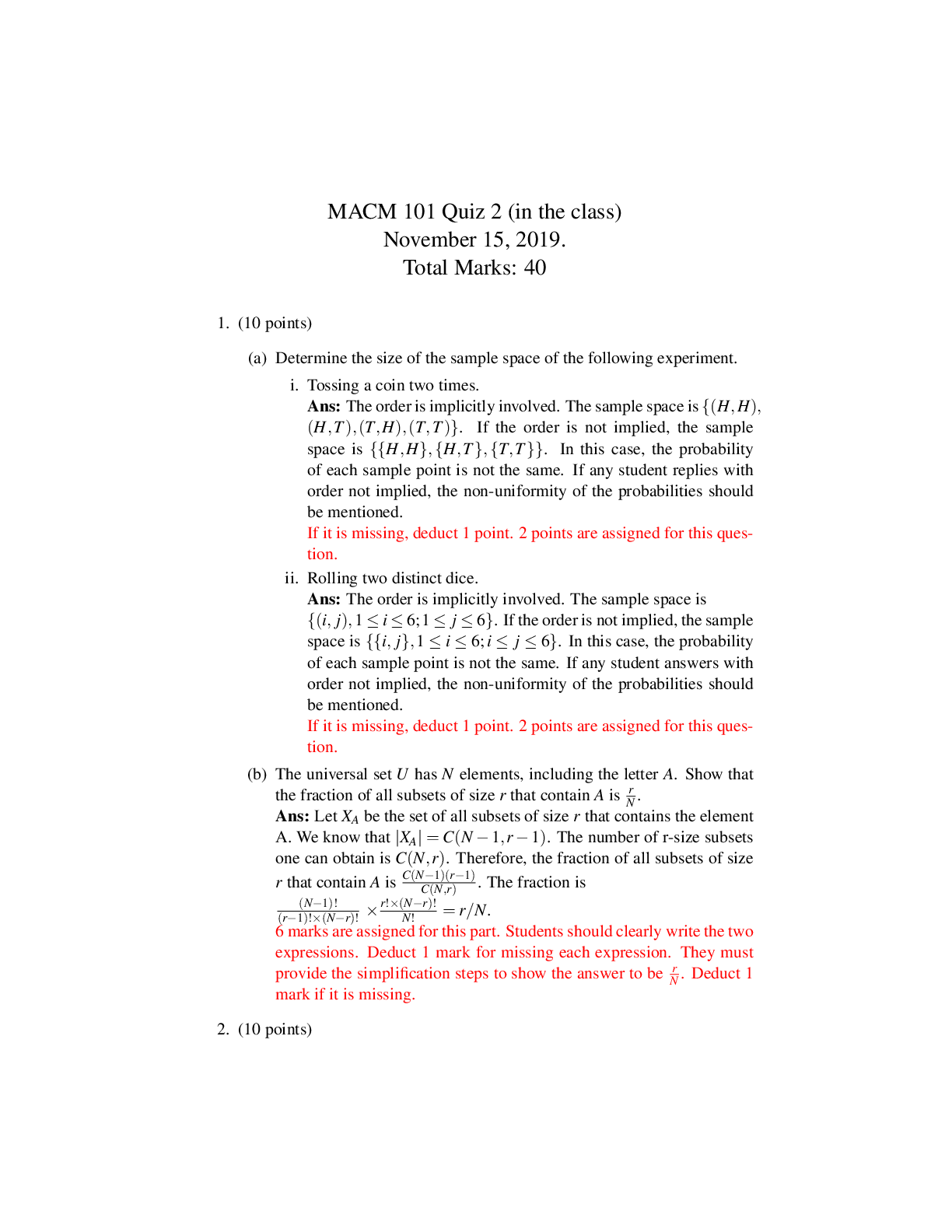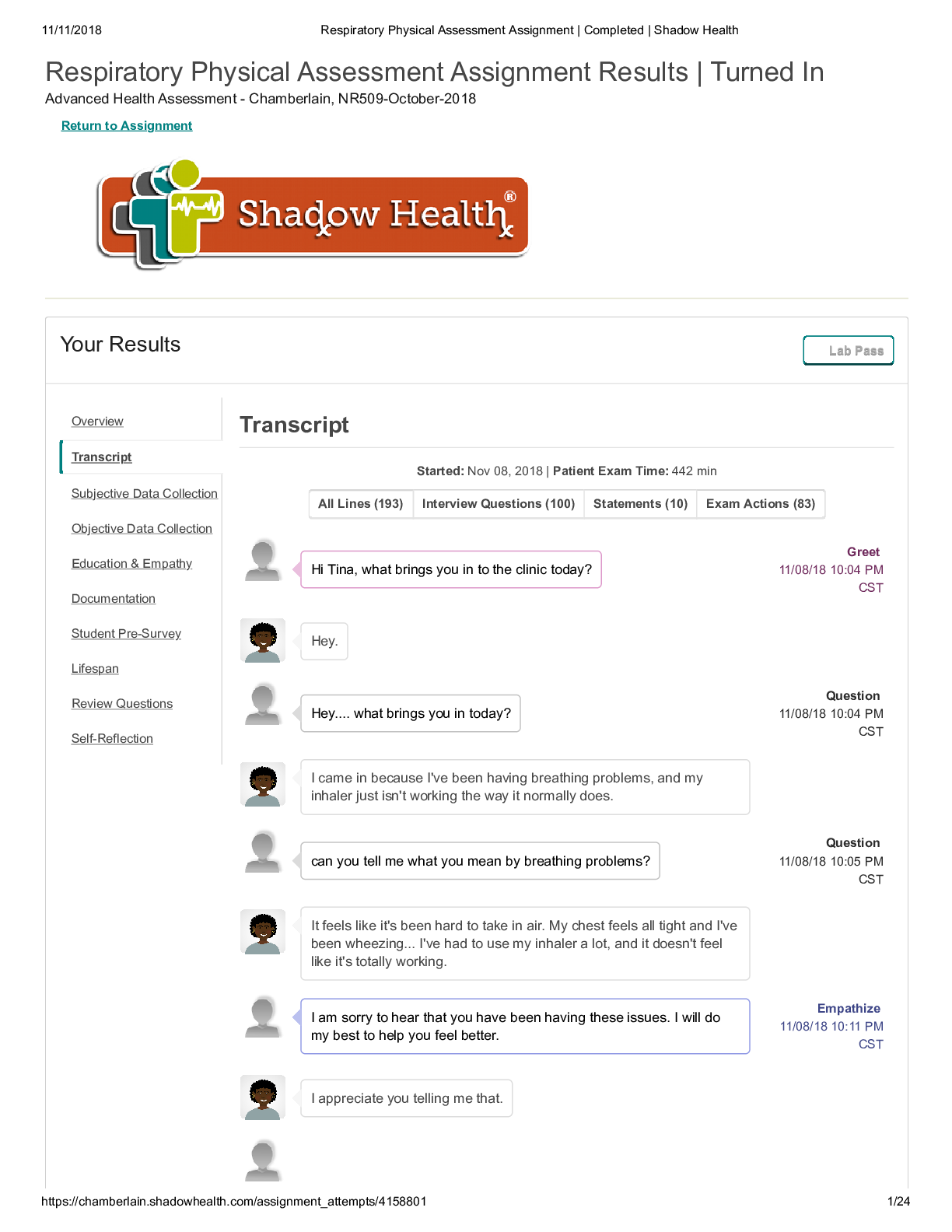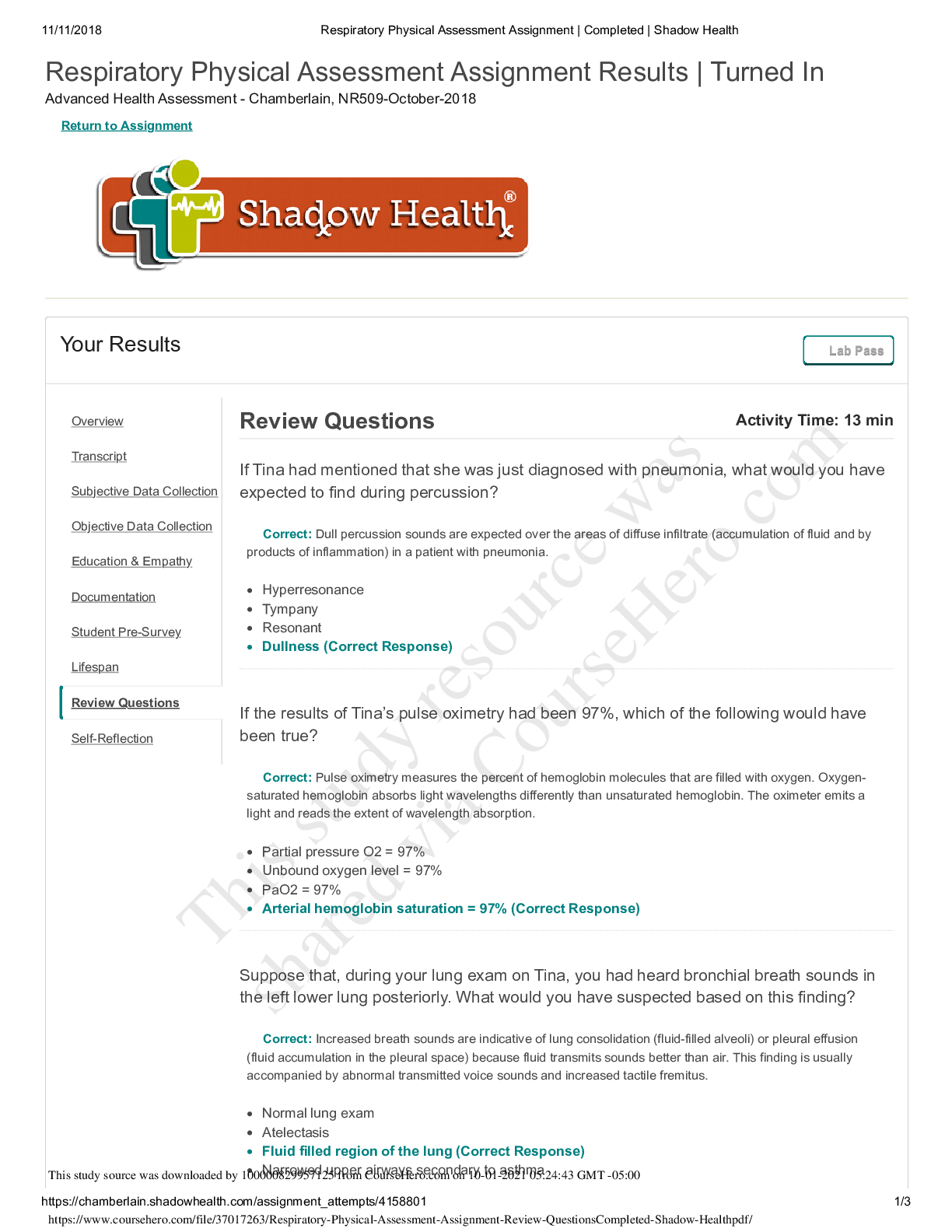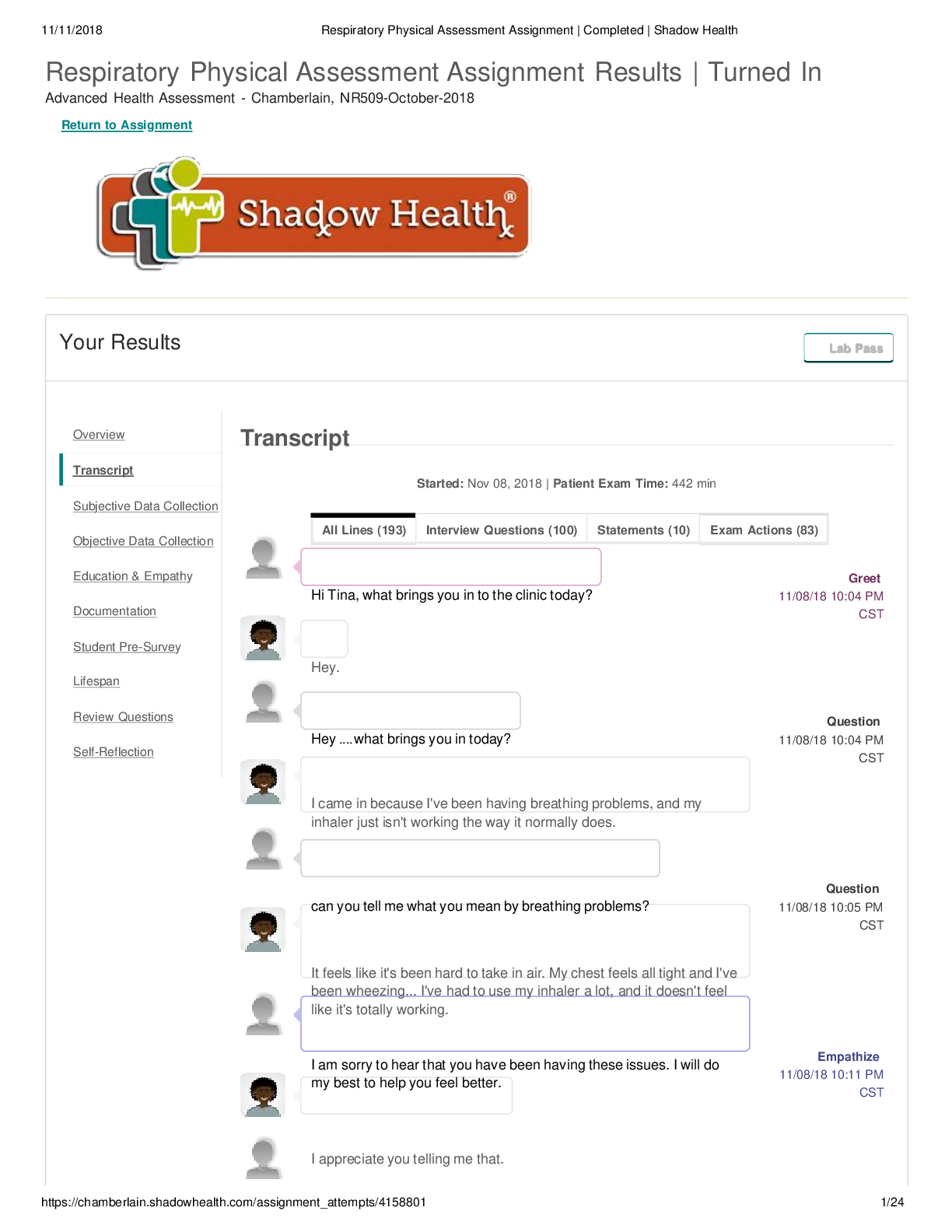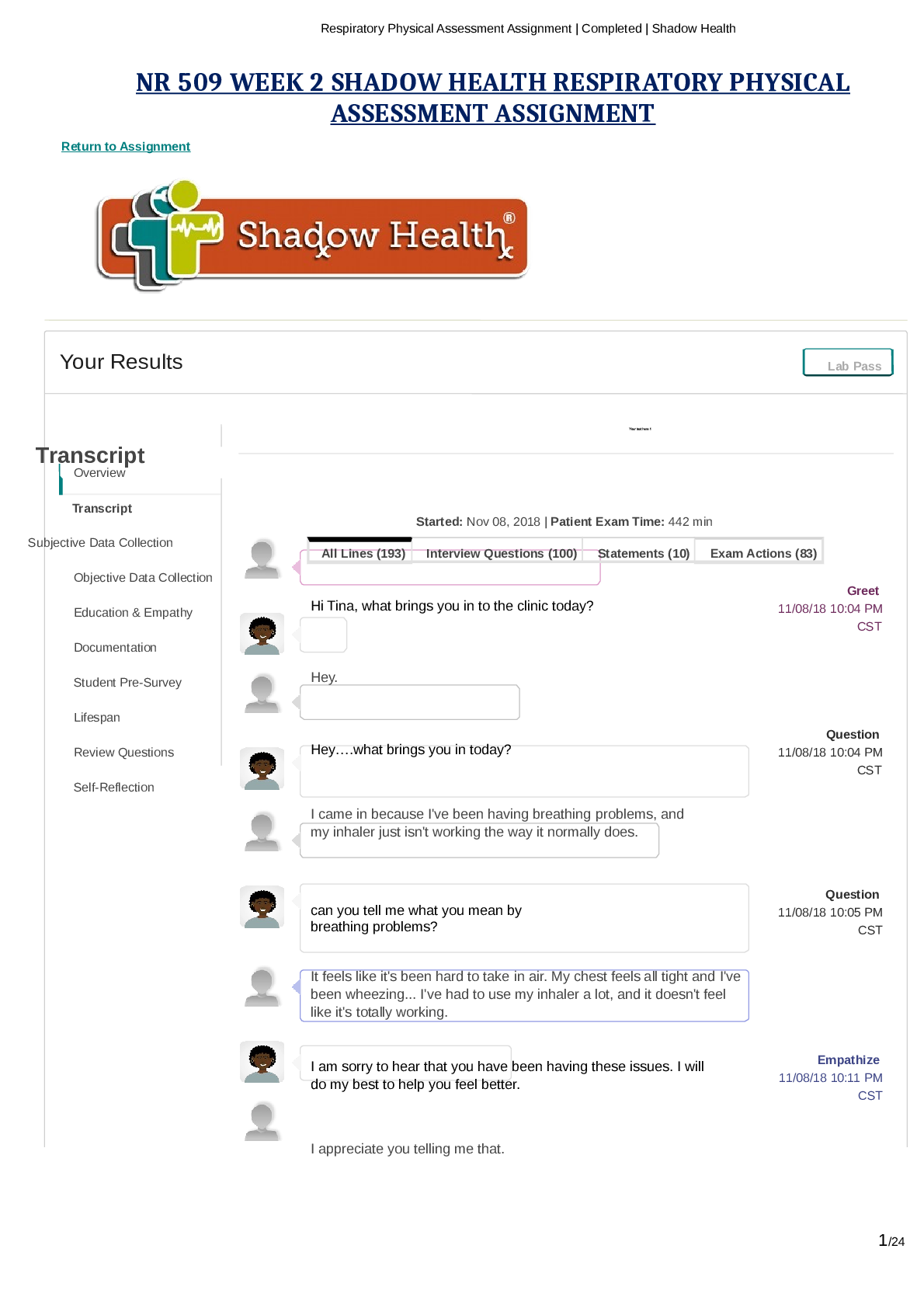NR 509 Respiratory Physical Assessment Assignment Documentation Completed
Document Content and Description Below
11/11/2018 Respiratory Physical Assessment Assignment | Completed | Shadow Health https://chamberlain.shadowhealth.com/assignment_attempts/4158801 1/5 Respiratory Physical Assessment Assignment Resu... lts | Turned In Advanced Health Assessment - Chamberlain, NR509-October-2018 Return to Assignment Your Results Lab Pass Lab Pass Document: Provider Notes Document: Provider Notes Student Documentation Model Documentation Overview Transcript Subjective Data Collection Objective Data Collection Education & Empathy Documentation Student Pre-Survey Lifespan Review Questions Self-Reflection Documentation / Electronic Health Record https://www.coursehero.com/file/37017336/Respiratory-Physical-Assessment-Assignment-Documentation-Completed-Shadow-Healthpdf/ This study resource was shared via CourseHero.com11/11/2018 Respiratory Physical Assessment Assignment | Completed | Shadow Health https://chamberlain.shadowhealth.com/assignment_attempts/4158801 2/5 Student Documentation Model Documentation Subjective CC:"hard to take in air. My chest feels all tight and I've been wheezing... I've had to use my inhaler a lot, and it doesn't feel like it's totally working." HPI: Onset: 2 days ago at her cousin's house after exposure to cats which exacerbated her asthma and reported symptoms. Location:Chest Duration: "Minute or two" for each episode reported with a total of 10 episodes in last 2 days per patient. Characteristics/Quality: Tightness, feelings of not being able to take in air. Aggravating factors/Associated Symptoms: Cats, dust, running up a flight of stairs. Worse upon exertion and when lying down flat. Relieving factors: Proventil inhaler, resting Treatment/Medications/Remedies:Proventil Inhaler, three puffs every 4 hours for past 2 days. Albuterol 90mcg/spray MDI Severity:7-8/10 FH:Sister with asthma SH:Supervisor at Mid-American Copy & Ship, currently lives with mother and younger sister. MH:States having all the required "shots they give you when you're a kid." Hospitlized as a child and teen for asthma. ED a few months ago for foot injury that has since healed. Updates to Meds: No updates. Previous medications continued. Updates to Allergies: Updated to include seasonal allergies/hay fever along with cats & dust ROS General/Constitutional: No weigth loss, fever, chills, weakness reported. Patient does report fatigue upon exertion that subsides at rest. Respiratory:"Been hard to take in air". Chest tightness & wheezing. HPI: Ms. Jones is a pleasant 28-year-old African American woman who presented to the clinic with complaints of shortness of breath and wheezing following a near asthma attack that she had two days ago. She reports that she was at her cousin’s house and was exposed to cats which triggered her asthma symptoms. At the time of the incident she notes that her wheezes were a 6/10 severity and her shortness of breath was a 7-8/10 severity and lasted five minutes. She did not experience any chest pain or allergic symptoms. At that time she used her albuterol inhaler and her symptoms decreased although they did not completely resolve. Since that incident she notes that she has had 10 episodes of wheezing and has shortness of breath approximately every four hours. Her last episode of shortness of breath was this morning before coming to clinic. She notes that her current symptoms seem to be worsened by lying flat and movement and are accompanied by a non-productive cough. She awakens with night-time shortness of breath twice per night. She complains that her current symptoms are beginning to interfere with her daily activities and she is concerned that her albuterol inhaler seems to be less effective than previous. Currently she states that her breathing is normal. Diagnosed with asthma at age 2.5 years. She has no recent use of spirometry, does not use a peak flow, does not record attacks, and does not have a home nebulizer or vaporizer. She has been hospitalized five times for asthma, last at age 16. She has never been intubated for her asthma. She does not have a current pulmonologist or allergist. Social History: She is not aware of any environmental exposures or irritants at her job or home. She changes her sheets weekly and denies dust/mildew at her home. She uses a hypoallergenic pillow cover and her mattress is one year old. She denies current use of tobacco, alcohol, and illicit drugs. She did smoke marijuana for 5 or 6 years, her last use was at age 21 years. She does not exercise. Review of Systems: General: Denies changes in weight, fatigue, weakness, fever, chills, and night sweats. • Nose/Sinuses: Denies rhinorrhea with this episode. Denies stuffiness, sneezing, itching, previous allergy, epistaxis, or sinus pressure. • Gastrointestinal: No changes in appetite, no nausea, no vomiting, no symptoms of GERD or abdominal pain • Respiratory: Complains of shortness of breath and cough as above. Denies sputum, hemoptysis, pneumonia, bronchitis, emphysema, tuberculosis. She has a history of asthma, last hospitalization was age 16, last chest XR was age 16. https://www.coursehero.com/file/37017336/Respiratory-Physical-Assessment-Assignment-Documentation-Completed-Shadow-Healthpdf/ This study resource was shared via CourseHero.com11/11/2018 Respiratory Physical Assessment Assignment | Completed | Shadow Health https://chamberlain.shadowhealth.com/assignment_attempts/4158801 3/5 Student Documentation Model Documentation Objective Ms. Jones is a 28 year old African American women who appears to be her stated age. She is found sitting upright on the exam table and does not appear to be in any acute distress. PE: General/Constitutional: Reports of fatigue with exertion due to SOB that subsides with rest. Patient observed at rest, does not appear to be fatigued or SOB at current. Respiratory: Chest appear symmetric upon inspection with expansion palpated equal bilaterally along with tactile fremitus. All areas of the chest wall are resonant with no areas of dullness noted. Breath sounds are present in all areas. Adventitious wheezing auscultated bilaterally in posterior upper and lower lobes. Negative bronchophony auscultated. Spirometry read: FEV1 3.15, FVC 3.91; ratio = 81%. SpO2: 97% per bilaterally pointer fingers on room air. Inhaler noted to be correct dose and up to date. General: Ms. Jones is a pleasant, obese 28-year-old African American woman in no acute distress. She is alert and oriented and sitting upright on exam table. She maintains eye contact throughout interview and examination. • Respiratory: Chest expansion is symmetrical with respirations. Normal fremitus, symmetric bilaterally. Chest resonant to percussion; no dullness. Bilateral expiratory wheezes in posterior lower lobes. Bilateral muffled words with notable expiratory wheezes in posterior lower lobes. No crackles. In office spirometry: FVC 3.91 L, FEV1/FVC ratio 80.56%. SpO2: 97%. Assessment Diagnosis 1 (Code): Mild to Moderate persistent asthma with acute exacerbation (J45.41). Ms. Jones has an increased need for her inhaler during times of increased activity and while lying flat, exacerbated by recent exposure to allergens. Notable wheezing auscultated bilaterally in patients posterior lobes along with unproductive cough reported. Diagnosis 2 (Code): Primary Spontaneous pneumothorax (J93.11). Ms. Jones has reported a feeling of chest discomfort described as "tightness" more than pain along with accompanied shortness of breath. Diagnosis 3 (Code): Acute bronchitis, unspecified (J20.9). Ms. Jones has reported having a cough along with shortness of breath. Wheezing was auscultated in patients bilateral, posterior lobes. Denies coughing up mucus and has been afebrile. Mild-persistent asthma with exacerbation Plan Plan for Diagnosis 1: Mild - Moderate persistant asthma with acute exacerbation Diagnostics: Obtained spirometry reading and SpO2 reading during office visit. Medication: Continue her short-acting Proventil inhaler along with a new prescription for a combination inhaled coritcosteroid and long-acting Diagnostics • Obtain office oxygen saturation Medication • NMT in office x 1 • Initiate step-up medication therapy with inhaled corticosteroid • Continue albuterol inhaler Education • Encourage Ms. Jones to continue to monitor https://www.coursehero.com/file/37017336/Respiratory-Physical-Assessment-Assignment-Documentation-Completed-Shadow-Healthpdf/ symptoms and log her episodes of asthma This study resource was shared via CourseHero.com11/11/2018 Respiratory Physical Assessment Assignment | Completed | Shadow Health https://chamberlain.shadowhealth.com/assignment_attempts/4158801 4/5 Student Documentation Model Documentation beta agonist, such as Advair or Symbicort, and directions to start taking over the counter Loratadine 10mg QD. Education: Swish and rinse mouth after every use of the combination corticosteriod/long-acting beta agonist in order to prevent thrush from the inhaled steroid. Also educate the patient on the importance of monitoring, tracking and maintaining her blood sugars with previously prescribed medications, which is especially important since we are ordering her steroids at this visit which can cause an increase in her already increased blood sugars. Educate patient on worsening signs & symptoms, such as increased difficulty in breathing/shortness of breath that does not subside with rest or Proventil inhaler fails to alleviate any symptoms (epocrates.com, n.d.). Diagnosis 2: Primary spontaneous pneumothorax Diagnostics:CXR &/or CT scan, ABGs Medication:Dependent on size of pneumothorax treatment could be as little as bed rest with O2 supplementation with a small (<15%) pneumo versus a larger pneumo (>15%) where treatment would consist of aspiration via thoracentesis catheter or chest tube drainage and possibly surgical intervention of greater than 30% (uptodate.com, 2018). Education: Educate the patient on the pathophysiology of primary spontaneous pneumothorax and also secondary spontaneous pneumothorax due to patients HX of asthma along with possibility of reoccurrence. Also educate patient on activities that she may want to avoid that could potentiate another episode such as air travel and scuba diving. Education would also be given on emergent reasons to seek medical attention such as: chest pain that radiates to the back and shoulder, severe shortness of breath, tachycardia, perioral cyanosis. Diagnosis 3: Acute bronchitis Diagnostics: Medication: OTC Ibuprofen 200-600mg q 4-6hrs or acetaminophen 650mg q 4-6hrs not to exceed 4000mg/day to help alleviate discomfort and if patient had been febrile, OTC mucolytic if patient had been reporting expectorating mucus. Education: Hand washing is the single most important piece of education that can be given to patients in helping to avoid illnesses. It would be beneficial to re-iterate this to the patient along with avoiding smoking and second-hand smoke. Follow-up: Schedule a phone visit in a few days along with an in office visit in 2 weeks for reevaluation of patients symptoms. Referral: Pulmonologist for PFT Reference symptoms and wheezing with associated factors and bring log to next visit • Encourage to wash bedding and consider dust mite covers to decrease allergic nighttime symptoms • Educate to increase intake of water and other fluids • Create Asthma Action Plan Referral/Consultation • Refer to allergy specialist for evaluation and testing Follow-up Planning • Order PFTs to be completed after exacerbation to have baseline available for future comparison • Instruct Ms. Jones on when to seek emergent care including episodes of chest pain or shortness of breath unrelieved by rest, worsening asthma symptoms or wheezing, or the sense that rescue inhaler is not helping • Revisit clinic in 2-4 weeks for follow up and evaluation https://www.coursehero.com/file/37017336/Respiratory-Physical-Assessment-Assignment-Documentation-Completed-Shadow-Healthpdf/ This study resource was shared via CourseHero.com11/11/2018 Respiratory Physical Assessment Assignment | Completed | Shadow Health https://chamberlain.shadowhealth.com/assignment_attempts/4158801 5/5 Student Documentation Model Documentation epocrates.com.(n.d.).Acute asthma exacerbation in adults. Retrieved from: https://online.epocrates.com/diseases/4535/Acuteasthma-exacerbation-in-adults/Differential-Diagnosis uptodate.com. (2018). Primary spontaneous pneumothorax in adults. Retrieved from: https://www.uptodate.com/contents/primaryspontaneous-pneumothorax-in-adults Comments If your instructor provides individual feedback on this assignment, it will appear here. © Shadow Health® 2018 https://www.coursehero.com/file/37017336/Respiratory-Physical-Assessment-Assignment-Documentation-Completed-Shadow-Healthpdf/ This study resource was shared via CourseHero.com Powered by TCPDF (www.tcpdf.org) [Show More]
Last updated: 2 years ago
Preview 1 out of 5 pages
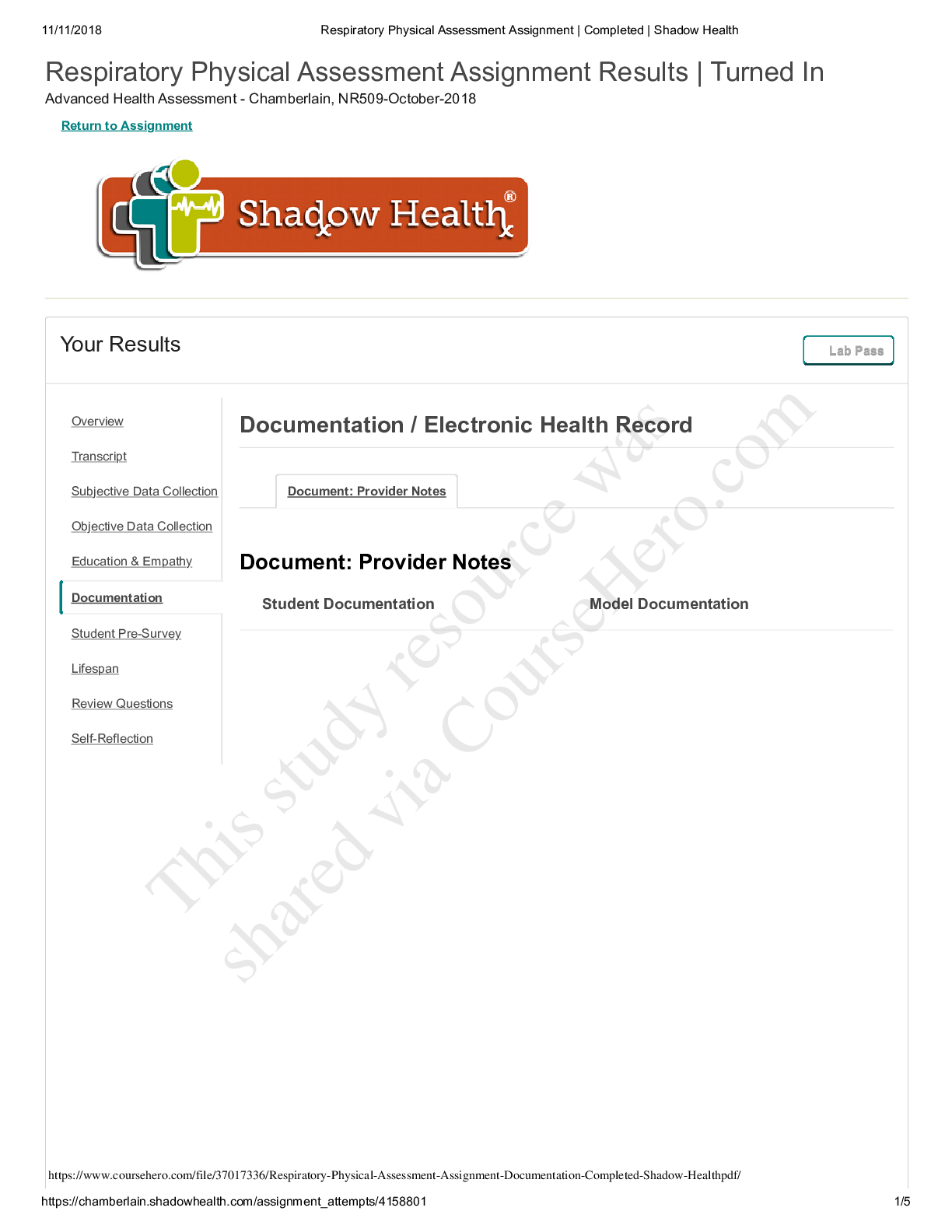
Buy this document to get the full access instantly
Instant Download Access after purchase
Buy NowInstant download
We Accept:

Reviews( 0 )
$10.00
Can't find what you want? Try our AI powered Search
Document information
Connected school, study & course
About the document
Uploaded On
May 14, 2021
Number of pages
5
Written in
Additional information
This document has been written for:
Uploaded
May 14, 2021
Downloads
0
Views
67







